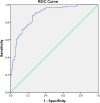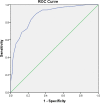A risk factor-based predictive model for new-onset hypertension during pregnancy in Chinese Han women
- PMID: 32245416
- PMCID: PMC7119175
- DOI: 10.1186/s12872-020-01428-x
A risk factor-based predictive model for new-onset hypertension during pregnancy in Chinese Han women
Abstract
Background: Hypertensive disorders of pregnancy (HDP) is one of the leading causes of maternal and neonatal mortality, increasing the long-term incidence of cardiovascular diseases. Preeclampsia and gestational hypertension are the major components of HDP. The aim of our study is to establish a prediction model for pregnant women with new-onset hypertension during pregnancy (increased blood pressure after gestational age > 20 weeks), thus to guide the clinical prediction and treatment of de novo hypertension.
Methods: A total of 117 pregnant women with de novo hypertension who were admitted to our hospital's obstetrics department were selected as the case group and 199 healthy pregnant women were selected as the control group from January 2017 to June 2018. Maternal clinical parameters such as age, family history and the biomarkers such as homocysteine, cystatin C, uric acid, total bile acid and glomerular filtration rate were collected at a mean gestational age in 16 to 20 weeks. The prediction model was established by logistic regression.
Results: Eleven indicators have statistically significant difference between two groups (P < 0.05). These 11 factors were substituted into the logistic regression equation and 7 independent predictors were obtained. The equation expressed including 7 factors. The calculated area under the curve was 0.884(95% confidence interval: 0.848-0.921), the sensitivity and specificity were 88.0 and 75.0%. A scoring system was established to classify pregnant women with scores ≤15.5 as low-risk pregnancy group and those with scores > 15.5 as high-risk pregnancy group.
Conclusions: Our regression equation provides a feasible and reliable means of predicting de novo hypertension after pregnancy. Risk stratification of new-onset hypertension was performed to early treatment interventions in high-risk populations.
Keywords: Homocysteine; Hypertension, pregnancy induced; Prediction model; Risk factors.
Conflict of interest statement
No benefits in any form have been received or will be received from a commercial party related directly or indirectly to the subject of this article.
Figures
Similar articles
-
Angiogenic markers and their longitudinal change for predicting adverse outcomes in pregnant women with chronic hypertension.Am J Obstet Gynecol. 2021 Sep;225(3):305.e1-305.e14. doi: 10.1016/j.ajog.2021.03.041. Epub 2021 Apr 1. Am J Obstet Gynecol. 2021. PMID: 33812812
-
[Regional analysis of high risk factors of hypertensive disorders in pregnancy with organ or system impairment].Zhonghua Fu Chan Ke Za Zhi. 2023 Jun 25;58(6):416-422. doi: 10.3760/cma.j.cn112141-20230218-00073. Zhonghua Fu Chan Ke Za Zhi. 2023. PMID: 37357600 Chinese.
-
A risk prediction model for renal damage in a hypertensive Chinese Han population.Clin Exp Hypertens. 2019;41(6):552-557. doi: 10.1080/10641963.2018.1523913. Epub 2018 Oct 9. Clin Exp Hypertens. 2019. PMID: 30299171
-
Prevalence of hypertensive disorders in pregnancy in China: A systematic review and meta-analysis.Pregnancy Hypertens. 2021 Jun;24:13-21. doi: 10.1016/j.preghy.2021.02.001. Epub 2021 Feb 14. Pregnancy Hypertens. 2021. PMID: 33626437
-
Long-Term Cardiovascular Disease Risk in Women After Hypertensive Disorders of Pregnancy: Recent Advances in Hypertension.Hypertension. 2021 Sep;78(4):927-935. doi: 10.1161/HYPERTENSIONAHA.121.16506. Epub 2021 Aug 15. Hypertension. 2021. PMID: 34397272 Free PMC article. Review.
Cited by
-
The association of serum total bile acid with new-onset hypertension during pregnancy.BMC Pregnancy Childbirth. 2022 Nov 26;22(1):879. doi: 10.1186/s12884-022-05211-y. BMC Pregnancy Childbirth. 2022. PMID: 36435758 Free PMC article.
-
Development of a prediction model on preeclampsia using machine learning-based method: a retrospective cohort study in China.Front Physiol. 2022 Aug 12;13:896969. doi: 10.3389/fphys.2022.896969. eCollection 2022. Front Physiol. 2022. PMID: 36035487 Free PMC article.
-
Interrelation among one-carbon metabolic (OCM) pathway-related indicators and its impact on the occurence of pregnancy-induced hypertension disease in pregnant women supplemented with folate and vitamin B12: Real-world data analysis.Front Nutr. 2023 Jan 10;9:950014. doi: 10.3389/fnut.2022.950014. eCollection 2022. Front Nutr. 2023. PMID: 36704788 Free PMC article.
-
Efficacy and safety of low dose aspirin and magnesium sulfate in the treatment of pregnancy induced hypertension: A protocol for systematic review and meta-analysis.Medicine (Baltimore). 2020 Nov 13;99(46):e22801. doi: 10.1097/MD.0000000000022801. Medicine (Baltimore). 2020. PMID: 33181650 Free PMC article.
-
Identifying Predictor Variables for a Composite Risk Prediction Tool for Gestational Diabetes and Hypertensive Disorders of Pregnancy: A Modified Delphi Study.Healthcare (Basel). 2024 Jul 8;12(13):1361. doi: 10.3390/healthcare12131361. Healthcare (Basel). 2024. PMID: 38998895 Free PMC article.
References
Publication types
MeSH terms
Grants and funding
- No. ZR2014HP046/Shandong Provincial Natural Science Foundation, China/International
- No. 2017WS462/Shandong Provincial Science and Technology Development Programme Foundation, China/International
- No. 2018GSF118009/Shandong Provincial Key Research and Development Programme Foundation, China/International
- No. 201821007/Technology Programme Foundation of Jinan, China/International
LinkOut - more resources
Full Text Sources
Medical



